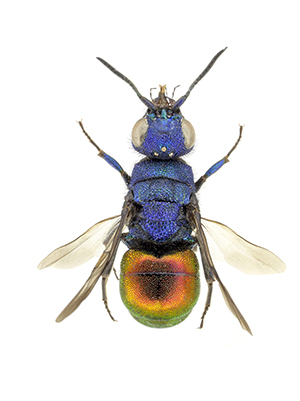Last updated on November 28th, 2023
 From: Kimsey L.S. & Bohart R.M., 1990 (1991) – The chrysidid wasps of the world. Oxford University Press, ix-652 pp.
From: Kimsey L.S. & Bohart R.M., 1990 (1991) – The chrysidid wasps of the world. Oxford University Press, ix-652 pp.
Synonymy
Hedychrum Latreille 1802:317. Type: Chrysis lucidula Fabricius 1775:358 (=Sphex nobilis Scopoli 1763:792). Monobasic.
Cymura Dahlbom 1845:4. Type: Cymura splendidula-DMbom 1845:4 (=Hedychrum coelestinum Spinola 1838:454). Monobasic.
Wollmania Mocsáry 1909:2. Type: Wollmania concinna Mocsáry 1909b:2. Monobasic.
Generic diagnosis
Face with sparse erect setae; scapal basin deeply concave, with transverse cross-ridging malar space less than 1 MOD; base of oral fossa with a sharp tooth; pronotum with anteromedial pit; notauli sulciform; mesopleuron rounded, with indistinct omaulus and short scrobal sulcus; metanotum rounded or rarely mucronate; propodeum without medial enclosure, with medial carina; mid and hind tibia with pit or depression on inner surface, rarely without; hind femur enlarged, anterior surface brown and microreticulate in males; tarsal claws with subparallel tooth, appearing apically bifid; fore wing medial vein slightly curved, arising at cu—a, stigma slender and apically acute; T-III usually with lateral tooth and subapically swollen, rarely with four apical teeth; female S-III with sub-basal sulcus extending toward mid-line and often with apicomedial tubercle; volsella divided into digitus and cuspis.
Hosts
Few hosts have been reported for Hedychrum but all are Sphecidae in the subfamily Philanthinae. Grandi (1961) gave Cerceris sabulosa Panzer as the host of gerstaeckeri, and in North America Byers (1978) reared an undetermined species of Hedychrum from Cerceris halone Banks. Hedychrum simile was observed by Tsuneki (1970a) leaving the nest of Cerceris arenaria L. Abeille (1877) reported rearing longicolle and sculpturatum from the cells of Halictus but this record is questionable.
Distribution
The Eastern Hemisphere has the highest diversity of Hedychrum, with 65 species in the Palearctic Region, 47 in Africa south of the Sahara, 4 in Madagascar, and 14 Oriental. In the Western Hemisphere there are 11 North American species and 5 South American.
Discussion
Hedychrum comprises a distinctive and closely related group of species, characterized by the mid and hind tibial pits, tooth at the base of the oral fossa, enlarged hind femur, modified female S-III, and special propodeal sculpture. Coloration is one of the most useful diagnostic features for species distinctions. The presence and extent of blue or green on S-II and -III is of critical importance. Males tend to have more extensive metallic coloration on S-II and -III. Species from the Americas and Afrotropical Region tend to be entirely blue or green, except cupricolle which has the pronotum, scutum, scutellum, and metanotum bright green to brassy, and contrasting strongly with the rest of the body. Palearctic species also tend to be bicoloured, but with a blue, green, or purple thorax, and brassy to coppery abdomen. Females of many of these, including nobile, aureicolle, longiolle, and chalybaeum, may have a strikingly bicoloured thorax similar to that of cupricolle. The shape and presence or absence of mid and hind tibial pits are also important characters. Finally, the shape or absence of the apicomedial tooth on the female S-III distinguishes many species.
This is a diverse but structurally conservative genus. There are few differences in lengths of flagellar articles, facial dimensions, or other sculptural features. Even the lengths of the clypeus (subantennal distance) or malar space vary only rarely. H. coelestinum can be recognized immediately by the unusually long clypeus.
Unlike most other elampines, sex determination in Hedychrum is relatively simple. Females have the modified S-III with sub-basal sulci and apicomedial tooth. The anterior surface of the hind femur is reticulate and non-metallic brown in males, and shiny green or blue in females. In addition, many Palearctic species have much more brightly coloured females than males. In the species listed above with a bicoloured thorax in females, the male thorax is entirely blue, green, or purple.
Hedychrum has only been revised on a regional basis, for Europe (Linsenmaier 1959a, b, 1987), southern Africa (Edney 1940), and North America (French in Bohart and Kimsey 1982).
European species
- Hedychrum aureicolle Mocsáry, 1889
- Hedychrum aureicolle rhodicyprium Linsenmaier, 1987
- Hedychrum chalybaeum Dahlbom, 1854
- Hedychrum cholodkovskii Semenov, 1967
- Hedychrum gerstaeckeri Chevrier, 1869
- Hedychrum gerstaeckeri plicatum Kilimnik, 1993
- Hedychrum longicolle Abeille, 1877
- Hedychrum luculentum Förster, 1853
- Hedychrum luculentum bytinskii Linsenmaier, 1959
- Hedychrum mavromoustakisi Trautmann, 1929
- Hedychrum micans europaeum Linsenmaier, 1959
- Hedychrum mithras Semenov, 1967
- Hedychrum niemelai Linsenmaier, 1959
- Hedychrum nobile (Scopoli, 1763)
- Hedychrum nobile antigai Buysson, 1896
- Hedychrum rufipes Buysson, 1893
- Hedychrum rutilans Dahlbom, 1854
- Hedychrum rutilans subparvolum Linsenmaier, 1959
- Hedychrum rutilans viridaureum Tournier, 1877
- Hedychrum rutilans viridiauratum Mocsáry, 1889
- Hedychrum semiviolaceum Mocsáry, 1889
- Hedychrum tobiasi Kilimnik, 1993
- Hedychrum virens Dahlbom, 1854
- Hedychrum virens caucasium Mocsáry, 1889
- Hedychrum viridilineolatum Kilimnik, 1993
Copyright, Authorship, and Ownership statements
All text and images of this page are copyright ©️ Chrysis.net unless otherwise stated - please see individual cases for authorship and copyright details. The specimens pictured are from the authors' or other collaborators' personal collections and from the collections of various museums. Unless otherwise specified, the whole content of this web site is for personal, non-commercial, scientific, and educational purposes given proper accreditation to the page from which they were derived are provided, and under Chrysis.net Terms and Conditions.
For citation purposes
Agnoli G.L. & Rosa P. (2025) Genus Hedychrum Latreille, 1802, in: Chrysis.net website. Interim version 22 April 2025, URL: https://www.chrysis.net/database/genus-hedychrum/.




